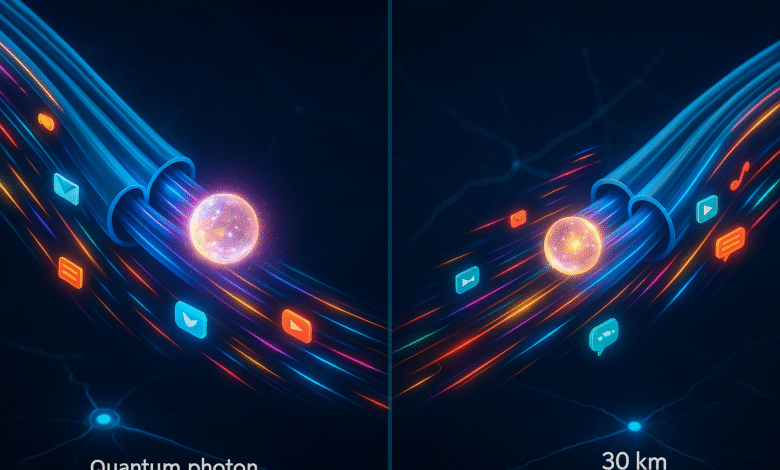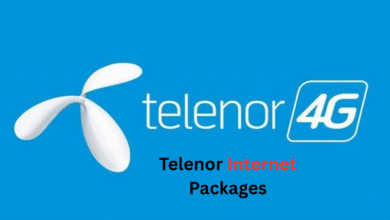
In 2024, scientists did something that sounds straight out of science fiction. They teleported a quantum state of light across more than 30 kilometers of fiber optic cable—while regular internet traffic was flowing through the same cables.
Yes, you read that right. They achieved quantum teleportation through the same cables carrying your emails, streaming videos, and social media updates.
Why This Matters (And Why You Should Care)
Before you get excited about teleporting to work, let’s be clear—this won’t help you skip traffic jams or make your cat videos load faster. But here’s what it will do:
This breakthrough opens the door to quantum-powered computer networks. Think ultra-secure encryption that’s virtually unbreakable. Imagine sensing technologies so advanced they could revolutionize everything from medical diagnostics to environmental monitoring.
“This is incredibly exciting because nobody thought it was possible,” says Prem Kumar, the Northwestern University engineer who led this groundbreaking study.
He’s not exaggerating. This achievement could change everything about how we think about internet infrastructure.
What Actually Happened Here?
Kumar’s team proved something remarkable: “Our work shows a path towards next-generation quantum and classical networks sharing a unified fiber optic infrastructure. Basically, it opens the door to pushing quantum communications to the next level.”
Understanding Quantum Teleportation
Think of quantum teleportation like a cosmic copy-and-paste operation. It’s not quite like Star Trek’s transporters that beam people across space instantly. Instead, it works more like this:
Scientists take the quantum possibilities of an object in one location. They carefully destroy the original. Then they force those same possibilities onto a similar object somewhere else. The two objects become “”entangled”—connected in ways that Einstein famously called “spooky action at a distance.”
Here’s the catch: This process still requires sending information between the two locations. That’s where things get tricky.
The Challenge: Quantum States Are Incredibly Fragile
Quantum states are like cotton candy in a rainstorm. They’re delicate, wispy things that can dissolve into nothing at the slightest disturbance.
Electromagnetic radiation buzzes around everywhere. Heat from moving particles creates interference. These forces constantly threaten to destroy quantum states through something called “”decoherence“—basically, the quantum magic disappears.
Protecting quantum states inside controlled laboratory computers? That’s challenging but doable.
But sending a single photon through fiber optic cables packed with internet traffic? That’s like trying to preserve a soap bubble while sending it through a hurricane.
You’re dealing with bank transactions, streaming videos, text messages, and countless other data streams all flowing through the same cables at 400 gigabits per second. The quantum photon needs to survive this digital chaos without losing its special properties.
The Breakthrough Solution
Kumar’s team didn’t just hope for the best. They engineered their way around the problem.
“We carefully studied how light is scattered and placed our photons at a judicial point where that scattering mechanism is minimized,” Kumar explains.
Think of it like finding the eye of a digital hurricane. The researchers identified specific wavelengths and channels where their quantum photon could travel safely alongside regular internet traffic.
“We found we could perform quantum communication without interference from the classical channels that are simultaneously present,” Kumar adds.
Why This Is Different From Previous Attempts
Other research teams had transmitted quantum information alongside classical data before. But here’s what made Kumar’s work special: they were the first to achieve actual quantum teleportation through real internet infrastructure.
Previous experiments used simulated internet conditions. Kumar’s team used the real deal—actual internet traffic flowing through working fiber optic networks.
That distinction matters enormously. It proves this technology can work in the real world, not just in perfectly controlled laboratory settings.
What Comes Next: The Quantum Internet Revolution
Each successful test like this brings us closer to something that once seemed impossible: a quantum internet.
This isn’t just a faster version of today’s internet. It’s a completely new way of transmitting and processing information. Here’s what becomes possible:
Ultra-Secure Communications: Quantum encryption is theoretically unbreakable. Any attempt to intercept the information destroys it, alerting both sender and receiver to the breach.
Quantum Computing Networks: Individual quantum computers could link together, creating computational power beyond anything we can imagine today.
Revolutionary Sensing: Quantum sensors could detect the tiniest changes in gravity, magnetic fields, or time itself. This could transform everything from medical imaging to earthquake prediction.
The Best Part: No New Infrastructure Needed
Here’s what makes this breakthrough truly exciting: We won’t need to rebuild the internet from scratch.
“Quantum teleportation has the ability to provide quantum connectivity securely between geographically distant nodes,” Kumar explains. “But many people have long assumed that nobody would build specialized infrastructure to send particles of light.”
That assumption just got shattered.
“If we choose the wavelengths properly, we won’t have to build new infrastructure. Classical communications and quantum communications can coexist.”
The Road Ahead
This successful demonstration proves that quantum and classical internet traffic can share the same highways. The quantum internet isn’t some distant dream requiring entirely new infrastructure.
Instead, it’s an upgrade to what we already have. The same fiber optic cables carrying this article to your screen could someday carry quantum-encrypted messages and quantum computing instructions.
We’re witnessing the birth of a new era in communications technology. And it’s happening through the same cables that brought you here to read about it.
The quantum internet is coming. And it’s going to use the infrastructure we already built.











